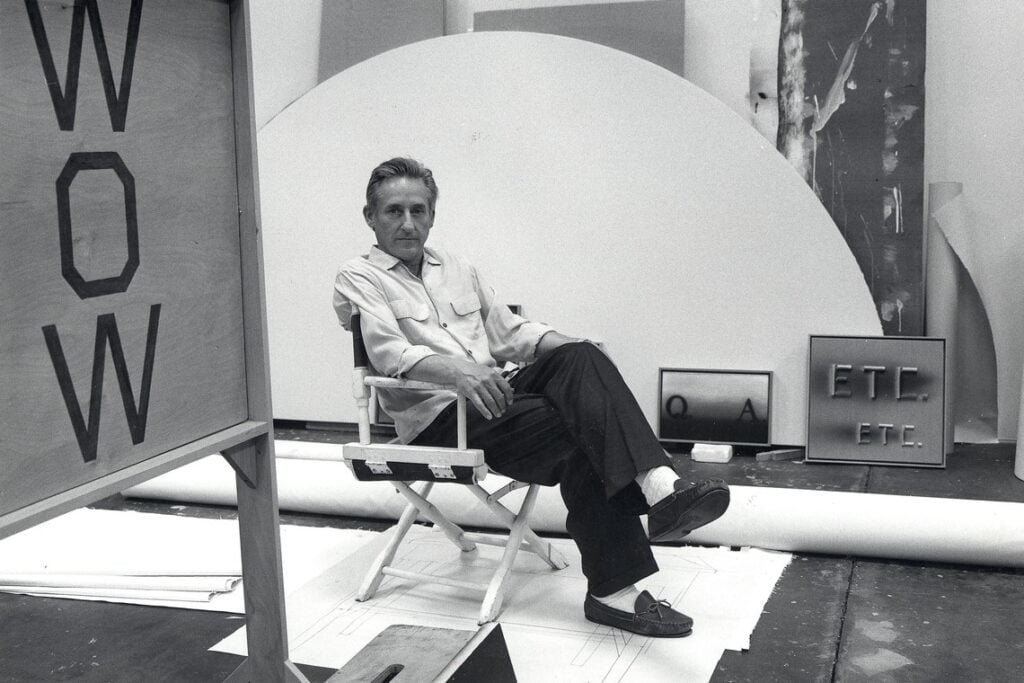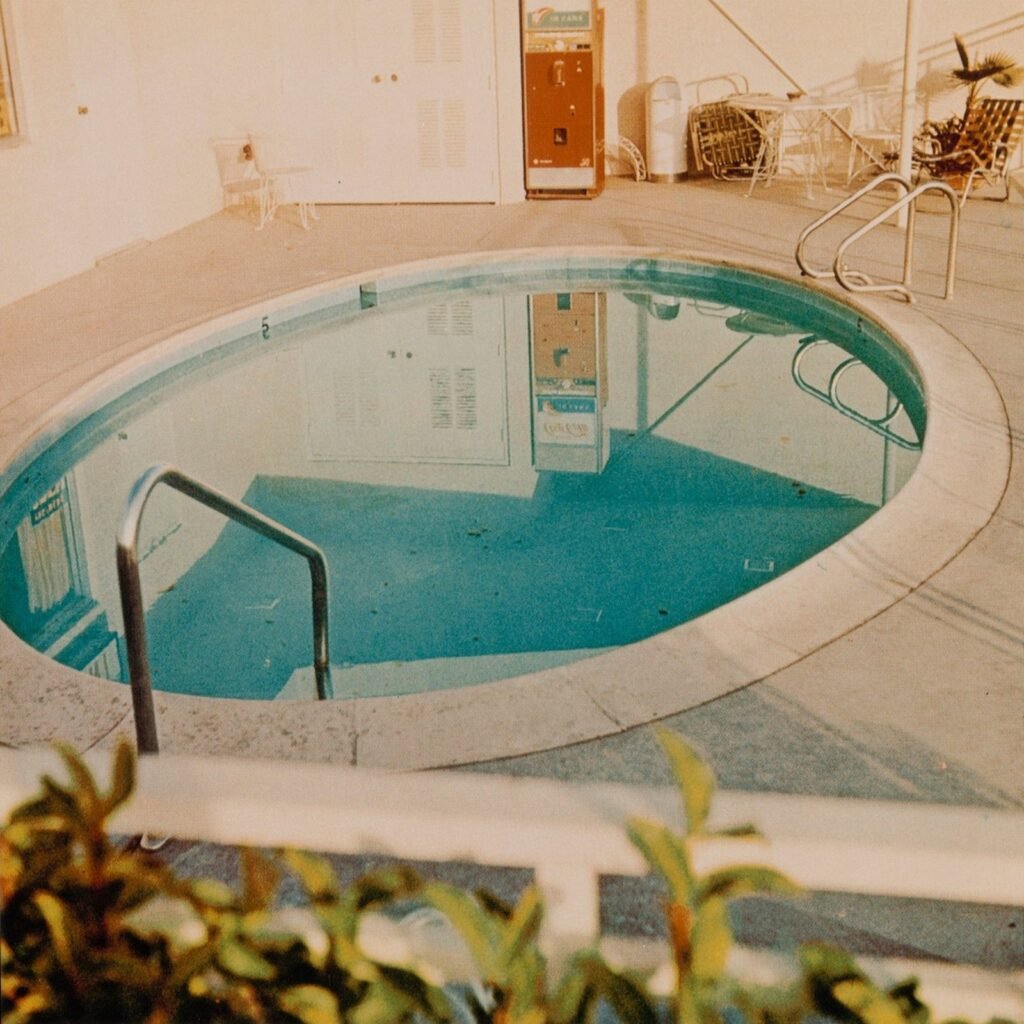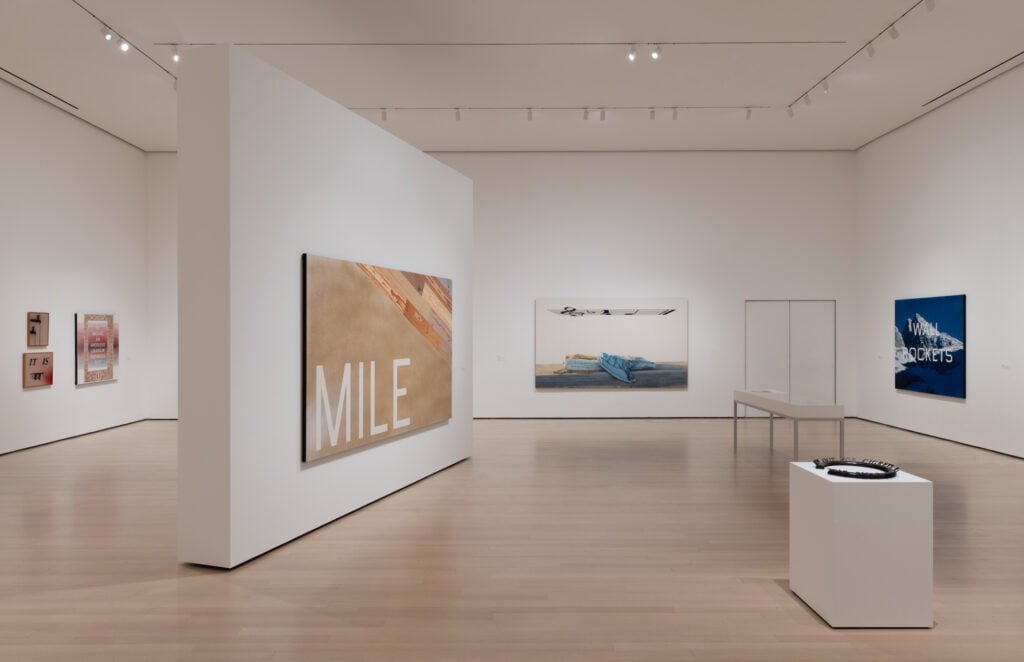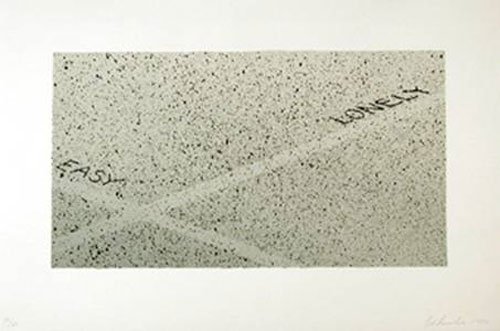Ed Ruscha BIOGRAPHY

Early Life and Education: Ruscha’s Upbringing in Oklahoma
Ruscha was born in Omaha, Nebraska, in 1937 but grew up in Oklahoma City, Oklahoma. His family moved there when he was an infant. His mother, an amateur artist, fostered Ruscha’s early interest in art. He developed a passion for drawing at a young age.
As a student, Ruscha had an aptitude for graphic design and typography. He attended the Chouinard Art Institute in Los Angeles, where he focused on commercial art training. His ambition was to become a sign painter. Ruscha was exposed to various artistic styles at Chouinard, from surrealism to pop art. His artistic style emerged, incorporating words and typography in visually striking compositions.
After graduating from Chouinard in 1960, Ruscha moved into a studio in the Los Angeles neighborhood of Venice. He began experimenting with painting, printmaking, and photography. His subject matter centered around iconic Los Angeles imagery, such as gas stations and the Hollywood sign. With a distinctive deadpan and irreverent style, Ruscha helped define the burgeoning West Coast pop art movement. His paintings incorporated commercial printing methods and a characteristic lack of emotion.
Ruscha’s artistic ambition and vision were apparent from an early age. His Oklahoma upbringing and education at Chouinard Institute shaped his signature style, making him one of the most prominent pop artists of his generation. Ruscha brought a quintessential Los Angeles vibe to the art world through his iconic paintings, prints, and photography.
What is Ed Ruscha known for?

Ed Ruscha is one of the pioneers of Pop Art in America. His dedication to capturing the mundane details of life in Los Angeles and the American West helped establish Pop Art as a movement that could tackle severe subjects with wit and irony. Ruscha’s prolific body of work has secured his place as one of the most influential artists of the 20th century.
Though his style has evolved over the decades, his paintings, prints, photographs, and films provide insightful social commentary on contemporary culture. Ruscha’s immense contribution to art history lives on in the many museums and private collections around the world that house his creations. His vision and voice gave shape to an artistic movement that endures today.
Career highlights

Moving to Los Angeles: Ruscha Arrives on the West Coast Art Scene
In the late 1950s, Ed Ruscha left behind the Midwest and headed west to Los Angeles. This move would prove pivotal in launching his career as an artist at the forefront of the Pop Art movement.
A New Community of Artists
Upon arriving in L.A., Ruscha found a burgeoning community of like-minded artists interested in popular culture and mass media. It included artists like Robert Irwin, John Baldessari, and Bruce Nauman. Ruscha began attending meetings at the Ferus Gallery, an avant-garde art space that exhibited many of these West Coast artists. Owner Walter Hopps offered Ruscha his first solo exhibition at Ferus in 1963.
Capturing the Visual Landscape
The sprawling cityscape of Los Angeles and its car culture became frequent subjects of Ruscha’s work. His paintings incorporated words and phrases referencing commercial signage and advertising.
Notable works include:
Large Trademark with Eight Spotlights | 1962 | These works employed a flat and graphic style to capture the experience of driving by and gazing at these roadside scenes. |
Standard Station | 1966 |
Ruscha’s time in Los Angeles was instrumental in developing his signature style. By depicting familiar city sights in his paintings, Ruscha helped define what would become known as West Coast Pop Art. His move west allowed him to break from tradition and forge new artistic territory with a group of like-minded contemporaries. This fertile environment enabled Ruscha to create innovative works that placed him at the forefront of the Pop Art movement.
Developing His Signature Style: When Did Ed Ruscha Become Famous?
In the early 1960s, Ed Ruscha began developing the signature style-defining his work and Pop Art in general. His paintings incorporated familiar imagery from popular culture, everyday objects, and Los Angeles cityscapes.
Ruscha was fascinated with the typography, signage, and logos around Los Angeles. He began incorporating words and phrases into his paintings, such as “Boss,” “Noise,” and “Greetings From LA.” His Word Paintings featured single words, multiple words, or nonsensical phrases spelled out in a deadpan style against monochromatic backgrounds. These paintings transformed ordinary language into artistic subjects, a hallmark of Pop Art.
Ruscha also pioneered new ways of depicting mundane subjects that had never been art’s focus. His Standard Station paintings featured stylized gas stations from the era, emphasizing their architectural uniformity and repetition. His Aerial Landscapes used aerial photography to capture nondescript parking lots, vacant lots, and suburban sprawl. These new subject matters and perspectives embodied a quintessential “Pop” sensibility by finding artistic inspiration in the commonplace.
What Type of Art did Ed Ruscha Make?
Pop Art
Modern Art
Contemporary Art
Ed Ruscha List of Work

Notable Works: Highlights from Ruscha’s Prolific Career
Over his 60-year career, Ed Ruscha created an extensive body of work that cemented his status as a pioneer of the Pop Art movement. Some of his most well-known creations are his word paintings, where he stenciled or hand-painted single words and short phrases onto canvas.
Notable Pieces are:
1962 | “Oof” |
1964 | Hurting the Word Radio” |
1988 | “Brave Men Run in My Family” |
Ruscha also produced several photo-based books.
Twenty-six Gasoline Stations | 1963 | This book contained black-and-white photos of gasoline stations along Route 66 between Los Angeles and Oklahoma. |
Other publications featured mundane subjects like:
Parking lots
Los Angeles County Museum of Art
Sunset Strip
These photo books highlighted Ruscha’s deadpan and ironic style.
Pencil Drawings
In the 1970s, Ruscha began experimenting with a variety of unconventional materials. For example, he created a series of “pencil drawings” by dragging pencils across large sheets of paper. He also made paintings using unconventional mediums like peach juice, axle grease, and gunpowder. These innovative techniques resulted in textured and collage-like surfaces.
Some of Ruscha’s most recognizable paintings are aerial views of the 20th Century Fox film logo.
1977 | The Back of Hollywood | This painting shows the iconic Hollywood sign and hillside from behind. These paintings demonstrate Ruscha’s lifelong fascination with Los Angeles and its car culture. They also reflect his ironic and quizzical perspective on American pop culture. |
Ruscha’s prolific career has spanned painting, drawing, photography, and film. His influential works provide insight into life in post-war Los Angeles, establishing him as a vanguard of West Coast Pop Art. Ruscha’s signature style, deadpan humor, and elevation of mundane subjects have enduring relevance and continue to inspire new generations of artists.
Follow Ed Ruscha on social media
Twitter: https://twitter.com/edruscha





